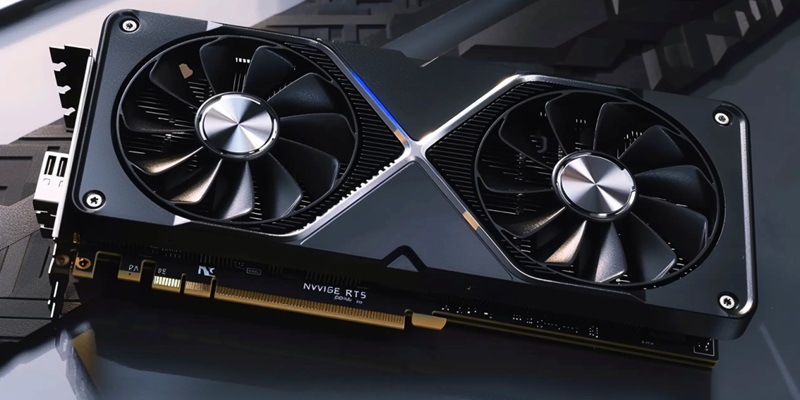Nvidia has confirmed the development of a new desktop GeForce RTX 3050 graphics card, aptly named the GeForce RTX 3050 A, which is set to utilize the Ada Lovelace-based AD106 chip. This revelation, initially hinted at through a PCI-ID database listing and later corroborated by Nvidia’s own drivers, adds a new dimension to Nvidia’s arsenal of graphics processing units. Despite retaining the xx50 class’s entry-level status, this new variant promises notable advancements that could redefine market expectations for budget-friendly GPUs.
The Shift to Ada Lovelace and AD106 Chip
Advanced Architecture and Specifications
Differentiating itself from predecessors that used the Ampere GA107 GPU, the GeForce RTX 3050 A is poised to leverage Nvidia’s Ada Lovelace architecture, marking a significant upgrade. This shift to the AD106 chip introduces 1,792 CUDA cores, 4 GB of GDDR6 VRAM on a 64-bit bus, and a TDP range of 35-50 watts. While these specifications indicate that it remains an entry-level card, the Ada Lovelace architecture is expected to bring efficiency and performance improvements that were previously unattainable in the xx50 series.
However, the decision to use the AD106 chip instead of the AD107, which is typically more suitable for the xx50 class, has raised eyebrows. The AD107 would be a more conventional choice for such a budget-focused card. This unconventional move could signal Nvidia’s attempt to push the boundaries of what an entry-level GPU can achieve, or it could be an experimental approach aimed at differentiating market segments. Regardless, the incorporation of the AD106 chip symbolizes a noteworthy step in the evolution of Nvidia’s product offerings.
Market-Specific Approach
Interestingly, reports suggest that this particular RTX 3050 A model might be exclusive to the Indian market, hinting at a strategic, market-specific release. Nvidia has employed similar tactics before, such as the unexpected launch of the GeForce RTX 2050 in 2021, which also catered to the entry-level GPU segment. This selective release strategy might aim to address specific regional needs or preferences, allowing Nvidia to optimize its global market presence.
By focusing on a region like India, Nvidia may be responding to a growing demand for budget-friendly, yet capable, gaming and computing hardware. Indian consumers have shown increasing interest in affordable technology that does not compromise on performance. Consequently, this exclusive release could bolster Nvidia’s market share in a region that balances price sensitivity with technological aspirations.
Broader Implications and Strategic Timing
Nvidia’s Quiet Introductions
Nvidia’s GeForce RTX 3050 A fits within the context of the company’s habit of quietly introducing variously specced GPUs, which occasionally show up without much fanfare. The GeForce RTX 3050 lineup already includes 6 GB and 4 GB variants, both leveraging the GA107 GPU. The decision to introduce a new configuration with the AD106 chip remains unexplained, but it may hint at Nvidia’s intention to experiment with different configurations to find the optimal balance between performance and cost.
This practice of quiet introductions allows Nvidia to gauge market reactions and fine-tune its offerings without committing to large-scale marketing campaigns. By adopting this strategy, Nvidia can subtly adjust its supply chain and product lineup based on real-world feedback rather than relying solely on preliminary market research. The unexpected nature of these introductions can also generate buzz within the tech community, sparking discussions and speculation that further enhance the brand’s visibility.
Preparing for the Future
As Nvidia prepares for CES, where it is expected to unveil Blackwell-based RTX 5000 models, the RTX 3050 A seems to be part of a broader strategy to cover diverse market segments with varying GPU needs. This methodical approach ensures that Nvidia remains competitive across all tiers of the GPU market, from entry-level to high-end. The upcoming CES event will likely provide further insights into Nvidia’s long-term plans and how the RTX 3050 A fits into their overall roadmap.
The introduction of the RTX 3050 A also reflects Nvidia’s continuous effort to refine its product lineup ahead of future high-end releases. By solidifying their presence in the entry-level segment, Nvidia ensures a robust, well-rounded portfolio that can attract a wide range of consumers. This strategy not only satisfies immediate market demands but also lays the groundwork for the successful launch of next-generation products.
Conclusion
Nvidia has made it official: they’re developing a new desktop GeForce RTX 3050 graphics card called the GeForce RTX 3050 A. This anticipated card will be powered by the Ada Lovelace-based AD106 chip. Initially, this development was hinted at through a PCI-ID database listing. However, the news gained substantial credibility when Nvidia’s own drivers confirmed the details. The introduction of the GeForce RTX 3050 A enhances Nvidia’s already extensive lineup of graphics processing units. Although it’s part of the xx50 class, which is traditionally considered entry-level, this new variant is expected to deliver significant improvements. These enhancements could potentially set new standards for what consumers can expect from budget-friendly GPUs. By leveraging advanced technology from the Ada Lovelace architecture, Nvidia aims to bring higher performance and greater efficiency to users who are mindful of their budget. The GeForce RTX 3050 A thus represents an exciting development, promising to offer advanced capabilities at a more accessible price point.

